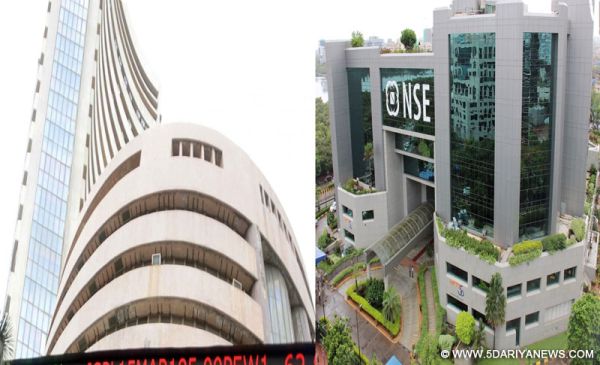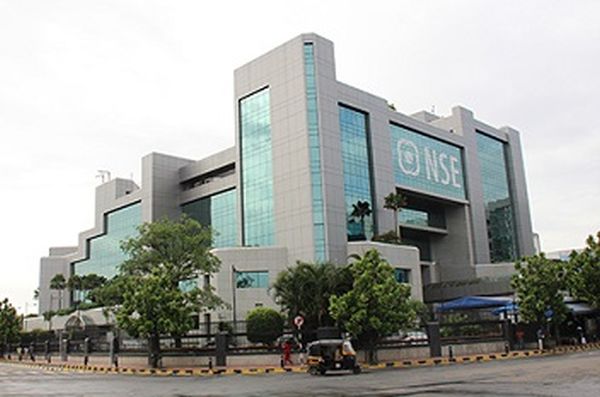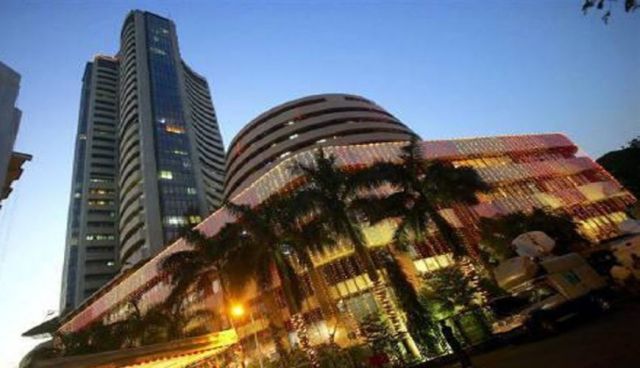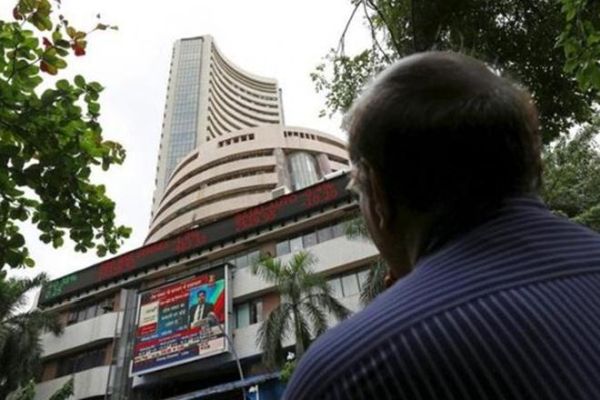
by admin | May 25, 2021 | Economy, Markets, News
 By Rohit Vaid,
By Rohit Vaid,
Mumbai : Macro-economic data points combined with the direction of foreign fund flows and the rupee’s movement against the US dollar are expected to influence the Indian equity market next week, analysts opined.
The ongoing quarterly results season, along with crude oil price fluctuations, will also impact investors’ risk-taking appetite.
“Market will closely watch the macroeconomic data, which are scheduled to release next week, crude oil prices, rupee movement and inflow or outflow of the funds by foreign and domestic investors,” SMC Investments and Advisors Chairman and Managing Director, D.K. Aggarwal told IANS.
Vinod Nair, Geojit Financial Services Head of Research: “A fall in interest rates and improving outlook for consumption oriented sectors after interim budget will provide support to the market.”
“On the global front, pessimism over growth and trade disputes may lead to volatility.”
The Central Statistics Office (CSO) is slated to release the macro-economic data points of Index of Industrial Production (IIP), Consumer Price Index (CPI) on February 12.
Besides, investors will look forward to the macro-economic data points of WPI (Wholesale Price Index) and India’s trade figures.
“Next week government will unveil CPI inflation and IIP date which will be keenly watched by the investors,” Nair added.
Apart from the macro-data economic data points, the week ahead will be heavily influenced by Q3 corporate earnings.
Companies like Eicher Motors, India Cements, Motherson Sumi Systems, SpiceJet, Coal India, Hindalco Industries, Indian Hotels, Bharat Forge, Fortis Healthcare, GMR Infra, ONGC and Voltas are expected to announce their quarterly results in the coming week.
In addition, direction of foreign fund flows will become other major sentiment driver.
The week ended on February 8 also witnessed an inflow of foreign funds as FIIs were net buyers to the tune of over Rs 2,265 crore, provisional data on the BSE showed.
On technical charts, the National Stock Exchange (NSE) Nifty50 broke-out of a two month trading range last week.
“Technically, the break-out was not followed up by follow-through up-move but sell-off at the end of the week. This made the breakout look less convincing as the Nifty has closed well below the highs of the week,” HDFC Securities’ Retail Research Head Deepak Jasani told IANS.
“We expect the Nifty to continue to trade in a range between the 10,852-11,082 levels for the coming week.”
Last week, both the key Indian equity indices — S&P Bombay Stock Exchange (BSE) Sensex and the NSE Nifty50 — rose on the back of Reserve Bank of India’s rate cut along with healthy foreign fund inflows.
Consequently, the S&P BSE Sensex rose 289.79 points, 0.8 per cent, over the week to end at 36,546.48 points.
The broader NSE Nifty50 finished at 10,943.60, up 1 per cent or 112.65 points from its previous week’s close.
(Rohit Vaid can be contacted at rohit.v@ians.in)
—IANS

by admin | May 25, 2021 | Banking, Economy, Markets, News
 By Rohit Vaid,
By Rohit Vaid,
Mumbai : The upcoming quarterly results season, along with the release of macro-economic industrial production data and global developments on trade protectionist measures, are expected to determine the trajectory of key equity indices next week.
Market observers opined that other global cues such as crude oil prices, combined with the direction of foreign fund flows and the rupee’s movement against the US dollar, will also have a bearing on the risk-taking appetite of investors.
“Investors have turned cautious ahead of corporate earnings season beginning next week, with TCS and Infosys reporting December quarter results in the first round. Going forward, the market is expected to continue its volatile trade,” SMC Investments & Advisors CMD D.K. Aggarwal said.
“Besides, developments in the Winter Session of Parliament, the movement of rupee against the dollar and crude oil price movement will further give direction to the
market.” (The Winter Session will run for just two more days on Monday and Tuesday.)
The Q3 earnings result season will kick-off from next week. IT major TCS is expected to be the first bluechip firm to come out with its Q3 result on January 10 (Thursday).
“The ongoing volatility may continue in the near-term, due to premium valuation, slowdown in the domestic economy, muted earnings growth in the next two quarters and cascading effect of liquidity crunch in the urban and rural markets,” Geojit Financial Services Head of Research Vinod Nair said.
“Additionally, the short-term effect of the national election (in the next few months), with risk of populist measures and the global effect of current uncertainties may add to the near term volatility. Markets will look forward to US-China trade talks and Q3 results season starting next week.”
Apart from TCS, companies like Infosys, Bajaj Corp and IndusInd Bank are expected to announce their quarterly results in the coming week.
Besides Q3 results, investors will look out for the upcoming macro-economic data points such as the IIP (Index of Industrial Production).
The Central Statistics Office (CSO) is slated to release the macro-economic data points of IIP and CPI on January 11 (Friday).
On the currency front, the rupee is expected to be volatile as crude and bond yields indicate pressure on the local currency said Sajal Gupta, Edelweiss Securities’ Head of Forex and Rates.
“Liquidity expansion in China can also put pressure on Asian currencies in the near future.. and global slowdown worries are not moving away….”
The local currency strengthened during the week ended January 4. It gained 43 paise to 69.72 against the US dollar from its previous week’s close of 70.15.
Another key theme for next week will be the direction of foreign fund flows. On a weekly basis, provisional figures from the stock exchanges showed that FIIs sold stocks worth over Rs 2,000 crore in the week just-ended.
On technical levels, the underlying trend of the National Stock Exchange’s Nifty50 has turned flat.
“Technically, with the moving average and momentum readings turning flat and the Nifty stuck in a range, markets could continue to remain choppy and range-bound in the coming week,” said Deepak Jasani, Head of Retail Research for HDFC Securities.
“The Nifty could broadly trade between the 10,534-10,924 points levels in the coming week.”
Last week, Indian equity market ended lower as concerns over a global slowdown and weak domestic core industrial production data dented investors sentiments.
Consequently, the 30-scrip Sensitive Index (Sensex) of the Bombay Stock Exchange edged lower by 381.62 points, or 1.05 per cent, to close at 35,695.10 points.
Similarly, the Nifty50 of the NSE declined. It went down by 132.55 points, or 1.22 per cent, to settle at 10,727.35 points.
(Rohit Vaid can be contacted at rohit.v@ians.in )
—IANS

by admin | May 25, 2021 | Economy, Markets, News
 By Rituraj Baruah,
By Rituraj Baruah,
Mumbai : Macro-economic indicators such as inflation, factory output as well as global crude oil prices will dictate the stock market trend next week, analysts said.
A string of assembly elections, starting November 12, will also drive investor sentiments after range-bound movement the previous week.
The government will release Consumer Price Index (CPI) and Wholesale Price Index (WPI) data for October next week.
Retail inflation for September was at 3.77 per cent, up from 3.69 in August. The wholesale inflation rose to 5.13 per cent in September, from 4.53 per cent in August.
Assembly elections kickstart with the first phase of elections in Chhattisgarh on Monday, November 12. Madhya Pradesh, Rajasthan, Chhattisgarh, Telangana and Mizoram go to polls this month and the next to reconstitute their respective assemblies.
The Bharatiya Janata Party (BJP) rules Madhya Pradesh, Rajasthan and Chhattisgarh, and a return to power in these states will bolster Prime Minister Narendra Modi’s chances of winning next year’s general election.
Also, crude oil prices, which have eased recently, would guide the equity market next week, analysts said.
In the week ended November 9, crude prices fell significantly from their recent highs. Brent crude oil is currently hovering around $70 per barrel, compared to $86 in early October.
India imports about 80 per cent of its crude oil requirements, and a spike in global rates triggers inflation concerns in Asia’s third-largest economy.
Strength of the rupee against the dollar would also be a key factor. On Friday, November 9, the Indian currency closed at 72.49 per dollar after logging a single-day gain of 51 paise. It had closed at 72.44 the previous week.
In a holiday-truncated week, the S&P Bombay Stock Exchange (BSE) Sensex gained 146.9 points, or 0.41 per cent, to close at 35,158.55 on Friday.
Similarly, the Nifty of the National Stock Exchange (NSE) advanced 32 points, or 0.30 per cent, to settle at 10,585.20.
The markets were shut on Thursday on the occasion of “Laxmi Pujan”. On Diwali the previous day, the BSE and the NSE conducted a special “Muhurat” trading between 5.30 p.m. and 6.30 p.m.
The provisional figures from the stock exchanges showed that foreign institutional investors bought scrips worth Rs 157.79 crore in the week ended November 9.
The domestic institutional investors sold Rs 813.42-crore stocks in the past week.
The Nifty is expected to face resistance at 10,755, while support is seen at 10,444, said Deepak Jasani, Head of Retail Reseach at HDFC Securities.
(Rituraj Baruah can be contacted at rituraj.b@ians.in )
—IANS

by admin | May 25, 2021 | Economy, Markets, News
 By Ravi Dutta Mishra and Rituraj Baruah,
By Ravi Dutta Mishra and Rituraj Baruah,
Mumbai : Quarterly results, along with manufacturing PMI and fiscal deficit data, are likely to drive the Indian equity market in the coming week.
Market participants and analysts expect value buying in the indices as the market has been largely bearish in the last couple of weeks.
In terms of quarterly results, companies like Bank of Baroda, Tata Power, Tata Motors, Union Bank of India, Lupin, DLF, HDFC, Axis Bank, Punjab National Bank, SAIL and Vedanta are likely to announce their second quarter earnings in the coming week.
Further, the Nikkei Manufacturing Purchasing Managers’ Index (PMI) for October will be released on Thursday, November 1, and the fiscal deficit data for September is due on Wednesday, October 31. This macroeconomic data would be key for the market sentiments.
“Manufacturing PMI and infrastructure output numbers will be seen crucially while leads will also be taken from ICICI Bank’s result (released on Friday). Mostly the trend will be in tandem with the global markets and indices such as S&P 500,” said Mustafa Nadeem, CEO, Epic Research.
On the technical front, the Nifty50 is seen receiving support at 9,951 points and 10,139 would be the immediate resistance level, analysts said.
In the week gone by, the National Stock Exchange (NSE) Nifty50 lost 273.55 points, or 2.65 per cent, on a weekly basis to settle at 10,030 points on Friday.
Similarly, the S&P Bombay Stock Exchange (BSE) Sensex lost 966.32 points, or 2.81 per cent during the week, to close at 33,349.31 points.
On Friday, both the Sensex and the Nifty dropped to seven-month lows.
“During the ongoing Q2 corporate earnings, companies declared lower-than-expected numbers which led to disappointment on the street. FII selling, lower-than-expected earnings and global markets sell-off combined, led to major selling in the markets,” said Rahul Sharma, Senior Research Analyst at Equity99.
In the coming week, the direction of flow of foreign funds will assume significance as there have been massive outflows in October, as investors pulled out from emerging markets to redeploy their capital in safe-havens such as US securities.
According to data provided by the National Securities Depository (NSDL), the monthly outflow of foreign funds at Rs 24,186 crore from the equity segment was at its highest so far in October.
The NSDL website has data from 2002, as Indian markets received minuscule funds from foreign investors prior to that, said Deepak Jasani, Head of HDFC Securities.
During the week just-ended, provisional figures from the stock exchanges showed that foreign institutional investors sold shares worth Rs 5,751.17 crore, whereas domestic institutional investors bought Rs 4,508.62 crore worth of stocks.
Figures from the NSDL showed that foreign portfolio investors divested Rs 4,563.31 crore, or $622.5 million, in the equities segment during the week ended October 26.
Besides, the rupee’s movement against the US dollar and global crude oil prices will also be closely followed by investors.
The Indian rupee on Friday closed at Rs 73.46 to a US dollar, weakening by 14 paise from its previous week’s close of 73.32.
(Ravi Dutta Mishra and Rituraj Baruah can be contacted at ravidutta.m@ians.in and rituraj.b@ians.in )
—IANS

by admin | May 25, 2021 | Economy, Markets, News
 By Rohit Vaid,
By Rohit Vaid,
Mumbai : Second-quarter earnings result season, combined with the direction of foreign fund flows and the liquidity situation of the NBFC (non-banking financial companies) sector are expected to determine the trajectory of Indian stock market indices during the upcoming week.
In addition, the price of global crude oil and the rupee-US dollar matrix will also be other major market themes during the period.
“Markets next week would again focus on the developments in the liquidity situation of the NBFCs, HFCs (housing finance companies),” Devendra Nevgi, Founder and Principal Partner, Delta Global Partners, told IANS.
The liquidity availability to the sector has become a concern after the default by some of the IL&FS Group companies.
Last Friday, the Reserve Bank of India (RBI) came out with new measures to increase the liquidity flow to NBFCs and HFCs.
“The ongoing turmoil led by a financial crunch in the domestic economy, global risk-off and worries over upcoming elections are likely to maintain their burden in the equity market,” said Vinod Nair, Head of Research at Geojit Financial Services.
“At the same time, it is possible that a good portion of these risk factors have been digested by the market and the upcoming impacts will depend on developments like stability in global bond yield and the trade war.”
In terms of quarterly results, companies like Adani Ports, Ambuja Cements, TVS Motor, Bajaj Auto, Wipro, Bharti Airtel, Biocon, Maruti Suzuki, Yes Bank, Dr Reddys Labs, ICICI Bank and ITC are expected to announce their Q2 earnings next week.
“The sentiment would be driven by the moves in the NBFC and HFC stocks and earnings of Asian Paints, Bajaj Group of companies, Bharti Airtel, etc., which are due next week,” Nevgi said.
Apart from the Q2 results, the direction of flow of foreign funds assumes significance as outflows from the beginning of October have crossed the highest level in the last 12 months.
As per data complied from the stock exchanges, in just 13 trading sessions from October 1 onwards, foreign investors have sold stocks worth around Rs 19,500 crore.
The weekly provisional figures showed that foreign institutional investors (FIIs) sold scrips worth Rs 1,576.01 crore.
Besides, the rupee’s strength against the US dollar and global crude oil prices will be closely followed by investors.
In the previous week, a decline in crude oil prices to below $80 per barrel and a stable rupee in a range of 73 to a US dollar helped buoy investor sentiments.
The Indian rupee last week closed at Rs 73.32 to a dollar, strengthening by 24 paise from its previous week’s close of 73.56.
“Lower oil prices and weakness in the US Dollar Index can offset the weakness in local stocks and keep the rupee in a range for the next week,” Anindya Banerjee, Deputy Vice President for Currency and Interest Rates with Kotak Securities, told IANS.
“… We can expect range-bound trading in the pair for the next week — between 73 and 74 levels on spot.”
On the technical charts, the National Stock Exchange (NSE) Nifty50 remains in an intermediate downtrend.
“Technically, with the Nifty again displaying weakness after the pullback rally seen in the previous week, the intermediate trend of the index remains down,” HDFC Securities’ Retail Research Head Deepak Jasani told IANS.
“The downtrend is likely to continue early next week once the immediate support of 10,250 points is broken. Crucial resistances to watch on the upside are at 10,436-10,526 points.”
Last week, mixed corporate earnings and fears of a slowdown in global economic growth, pulled the two main indices of the Indian stock market lower.
Consequently, on a weekly basis, the S&P Bombay Stock Exchange (BSE) Sensex closed at 34,315.63 points, down by 417.95 points or 1.20 per cent from its previous close.
Similarly, the wider Nifty50 of the NSE edged-lower. It closed at 10,303.55 points, down 168.95 points or 1.61 per cent from the previous week’s close.
(Rohit Vaid can be contacted at rohit.v@ians.in )
—IANS





